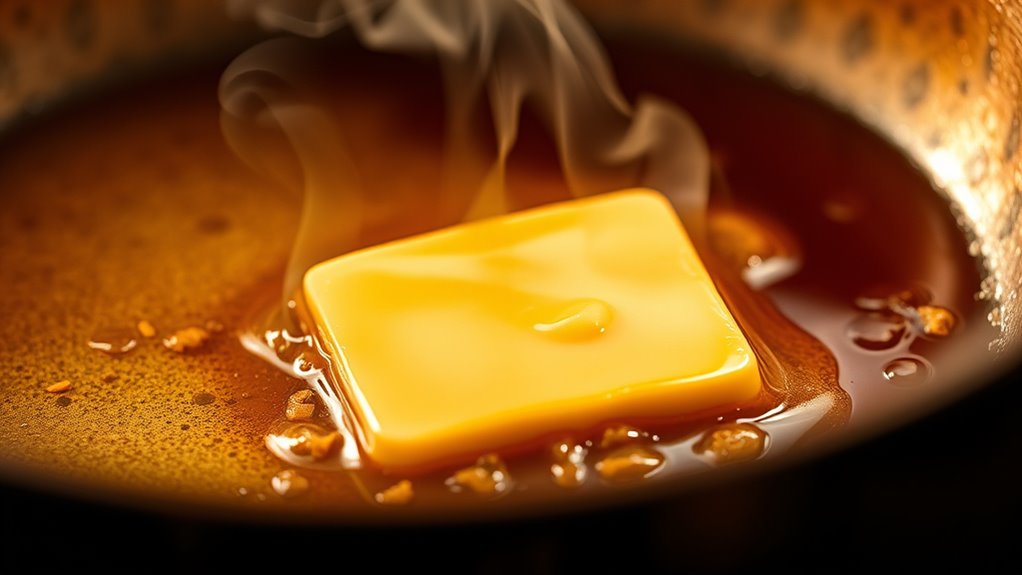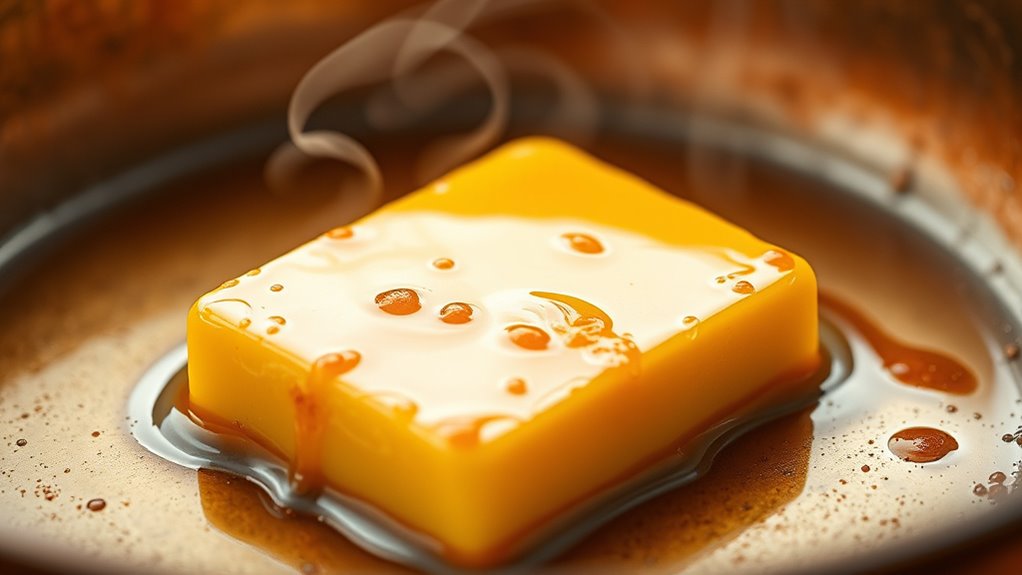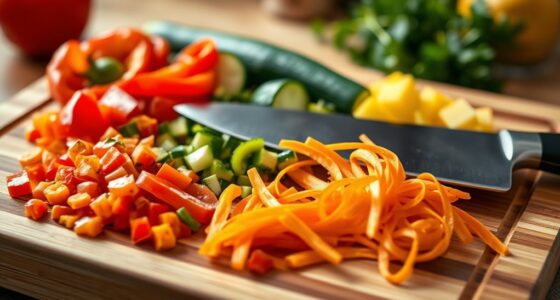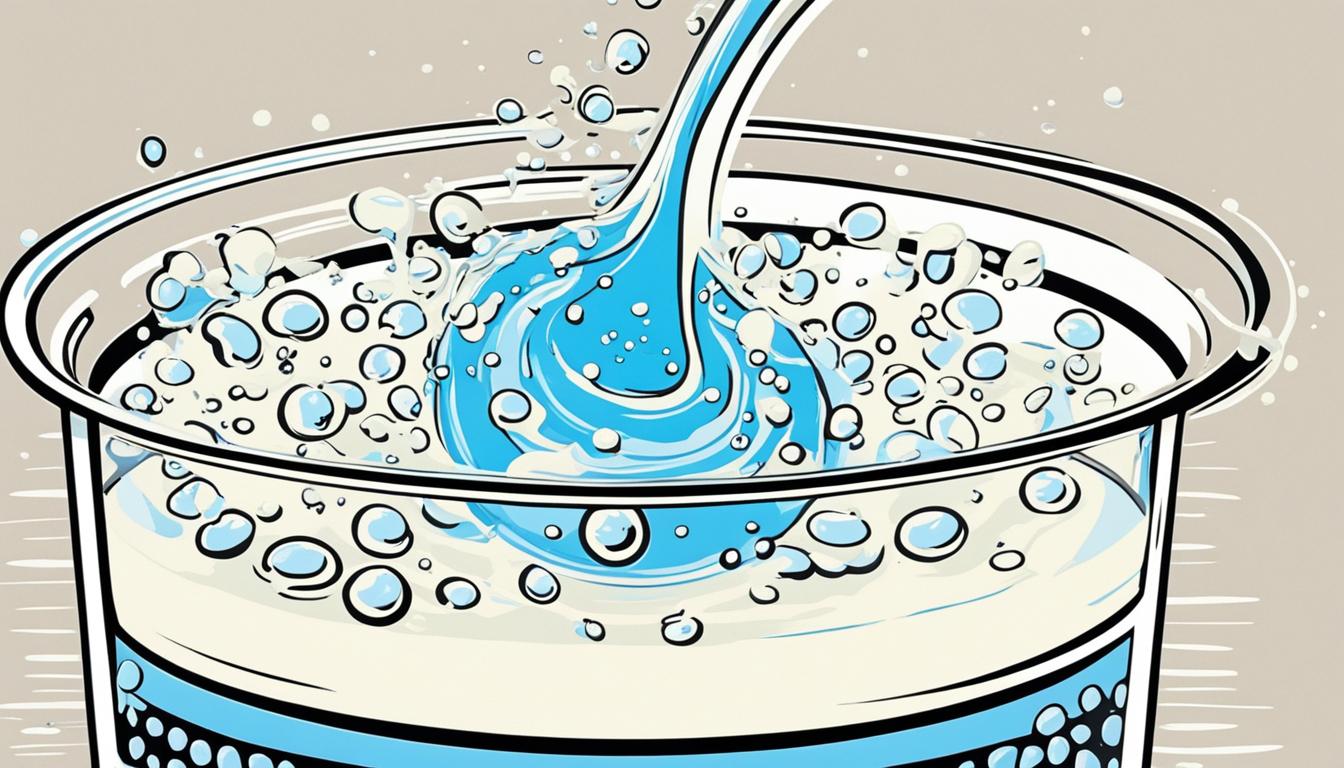The irresistible flavor of brown butter comes from the chemistry of Maillard reactions and lipid oxidation. When you heat butter, amino acids and sugars react, creating toasted, nutty, and caramel-like aromas. Meanwhile, fats break down, producing flavorful aldehydes and ketones that deepen the taste. These complex chemical changes give brown butter its rich, irresistible flavor. If you keep exploring, you’ll discover how controlling these reactions can elevate your culinary creations even further.
Key Takeaways
- The Maillard reaction creates toasted, nutty flavors by combining amino acids and sugars under heat.
- Lipid oxidation produces aldehydes and ketones that add deep, caramelized notes to brown butter.
- Molecular interactions between milk proteins and sugars during heating enhance flavor complexity.
- Gradual color darkening and aroma intensification signal optimal flavor development without burning.
- Proper temperature control ensures ideal chemical reactions, resulting in the irresistible, rich taste of brown butter.

Have you ever wondered what transforms plain butter into the rich, nutty flavor of brown butter? The secret lies in a combination of chemical reactions, primarily the Maillard reaction and lipid oxidation, which work together as butter cooks. When you heat butter, the milk solids—proteins and sugars—begin to undergo complex changes. As the temperature rises, these molecules start to interact, leading to the Maillard reaction. This reaction is responsible for creating those deep, toasted aromas and the characteristic nutty flavor that makes brown butter so irresistible. Essentially, the Maillard reaction involves amino acids and reducing sugars reacting under heat, forming new flavorful compounds that give brown butter its distinctive taste and aroma.
The transformation of butter into brown butter results from Maillard reaction and lipid oxidation during heating.
Simultaneously, lipid oxidation plays a vital role in developing the complex flavor profile of brown butter. As butter heats, the fats—mainly triglycerides—break down and react with oxygen, producing a variety of aldehydes, ketones, and other volatile compounds. These oxidation products add depth and richness, contributing to the buttery, caramelized notes you love. While oxidation might sound undesirable in other contexts, here, it’s a key process that enhances flavor rather than spoils it. The balance between Maillard reaction and lipid oxidation is delicate; too high a temperature or prolonged cooking can lead to burnt flavors, but when managed properly, it results in a beautifully nuanced taste.
The transformation of butter into brown butter is a slow, deliberate process. As you watch it cook, you’ll notice foam forming and subsiding, and the color gradually darkening. This visual cue signals the ongoing chemical reactions. The aroma intensifies, becoming more complex and inviting. The temperature at which you cook the butter determines how far these reactions go—too hot, and you risk burning the milk solids; too low, and the flavor won’t develop fully. Patience and careful heat control allow the Maillard reaction and lipid oxidation to work harmoniously, revealing the full potential of butter’s flavor.
Understanding the chemistry behind brown butter helps you appreciate why it tastes so much more than just melted butter. It’s a symphony of molecular changes—where proteins and sugars dance through the Maillard reaction, and fats undergo oxidation—culminating in a deeply flavorful, aromatic condiment. Recognizing how chemical reactions influence flavor development allows you to refine your technique for perfect results every time. Once you grasp these processes, you can master the art of making perfect brown butter, elevating your cooking with its rich, irresistible taste.
Frequently Asked Questions
Can Brown Butter Be Made With Other Types of Fat Besides Butter?
Yes, you can make brown butter with alternative fats like ghee, coconut oil, or even peanut butter, each bringing unique flavor variations. These fats can be browned similarly, developing rich, nutty notes that enhance dishes. Keep in mind, the taste will differ depending on the fat used, but the process remains similar, allowing you to experiment with different flavors while achieving that desirable brown, caramelized color.
How Does Aging Butter Affect the Browning Process?
Imagine butter aging as a slow dance, where time whispers secrets into its flavor. As you let butter age, it undergoes subtle changes that enhance flavor development, making the browning process richer and more complex. The aging process intensifies the butter’s natural sweetness and nutty undertones, allowing you to achieve deeper, more intricate browning when you cook it. So, aging butter is like crafting a fine wine—adding depth to each golden note.
What Is the Ideal Temperature Range for Browning Butter?
You should aim for a temperature range of 300-350°F (150-175°C) when browning butter. Proper temperature control is essential for ideal flavor development, as too high a heat can burn the butter, while too low slows the process. Keep a close eye and stir constantly to guarantee even browning, revealing those rich, nutty flavors that make brown butter so irresistible.
Does the Milk Source Influence the Flavor of Brown Butter?
You might wonder if milk source influences brown butter flavor. Investigating this, you’ll find that milk origin does cause flavor variation. Different cows, regions, and feed impact the butter’s richness and nuttiness, which then subtly alters the brown butter’s taste. So, yes, your milk’s origin can make a noticeable difference, adding unique nuances to each batch. Expect a richer, more complex flavor depending on where and how your milk is produced.
Are There Health Benefits or Risks Associated With Brown Butter?
You might wonder about the health implications of brown butter. While it offers rich flavor, it’s high in saturated fats and calories, which can impact heart health if consumed excessively. Its nutritional content includes fat-soluble vitamins like A and E, providing some benefits. However, moderation is key to avoid risks like elevated cholesterol. Enjoy brown butter, but balance it with healthier options for overall well-being.
Conclusion
So, next time you turn butter to amber perfection, remember it’s not just heat—it’s a magic trick of chemistry transforming simple ingredients into a symphony of flavor. As the aroma wafts through your kitchen like a warm hug, you’re savoring more than just butter; you’re experiencing a dance of molecules that ignites your senses. Brown butter isn’t just a cooking step; it’s a flavorful alchemy that turns everyday into extraordinary.










